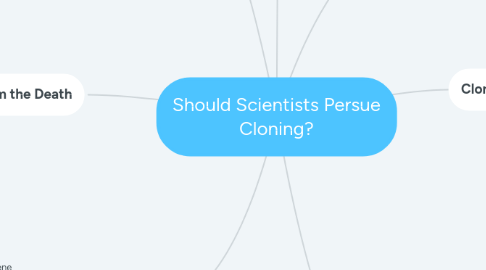
1. Pharming
1.1. In this it is given an animal a useful gene from other species, or types of animals.
1.2. Example
1.2.1. Animals can be given certain human genes so they produce important substances in their milk, blood or urine. These substances could be extracted and used as medicine for humans.
2. Back from the Death
2.1. This technology can bring extinted animals back to life
2.1.1. Now at days it exists companies that offer to clone sets that have already died, although it is really expencives
2.1.1.1. Example
2.1.1.1.1. Little Nicky, who is the fritas clone to order
2.1.2. Eventhough they have the same gene the individual may not look or behave the same, because there are factors such as the environment is which it lives that influences in many characteristics that makes it unique.
2.2. Saving Endangered Species
2.2.1. It is more difficult to clone endangered species because scientists don´t know much about their bodies and can´t take them out of their natural habitad.
2.2.2. A way to make a research the of cloning is to use eggs and sugorrate mothers from different species that is closely related to the endangered specie.
3. Cloning Human Cells
3.1. Researchers are cloning human cells to fin new ways to fight diseases
3.2. Stem Therapy
3.2.1. This therapy consists on takíng away the stem cells of a healthy person and injected into a patient.
3.2.1.1. Stem cells are "master cells" that can develop into other types of body cells
3.2.2. Therapeutic Cloning
3.2.2.1. Cloning the embryos is a better way to make this therapy, beacuse sometimes the body rejects the stem cells.
3.2.2.1.1. One of a patinent´s body cell could be turned into an embryo. The stem cell inside the embryo, and any body cell grown from them, would be exacto match to the patinent.
4. Cloning
4.1. Is the process of generating a genetically identical copy of a cell or an organism.
5. Cloning in Nature
5.1. The cells of the human body are cloning constantly to replace old or damage cells.
5.2. Some plants and animals clone themselves to produce offsprings.
6. Answer
6.1. Most expercts think that an overall yes or no answer this question would not be good. The best approach is to review each use of cloning on a case-by-case basis.
6.1.1. Consider
6.1.1.1. Ethical questions
6.1.1.2. Moral Questions
6.1.1.3. Technical questions
7. Artificial Cloning
7.1. Cloning Plants
7.1.1. Farmers and gardenias have been arctificially cloning plants, this allows a plant characteristic to be reproducen cheaply on a huge scale.
7.1.2. Types
7.1.2.1. Taking Cutting
7.1.2.1.1. Cut a piece off the plant and give the cutting light, water, and nutrients it needs to grow into a new plant.
7.1.2.2. Tissue Culture
7.1.2.2.1. Works in a similar way as Taking Cutting, but it uses much smaller pieces of the parent plant. Then hundreds of clones can be created from one plant.
7.2. Cloning Animals
7.2.1. It is much difficult than cloning plants.
7.2.2. First, it is needed an embryo, this can be removed from a pregnant animal or an egg can be fertilized and it starts developing into an embryo (this is called in vitro fertilization. When an embryo is just a few days old, all of its cells are identical. If the embryo is split in two or more pieces, each one devolpe into an individual.
7.2.3. Cloning an adult animal
7.2.3.1. The only way to clone an animal with the same characteristics as its parents its by cloning an adult.
7.2.3.2. A body cell from an adult is adjust and it becomes an embryo. Then the baby that is developed from the embryo has the same genetic information as the animal whose body cell was used.
7.2.3.3. Example
7.2.3.3.1. Dolly the Sleep
